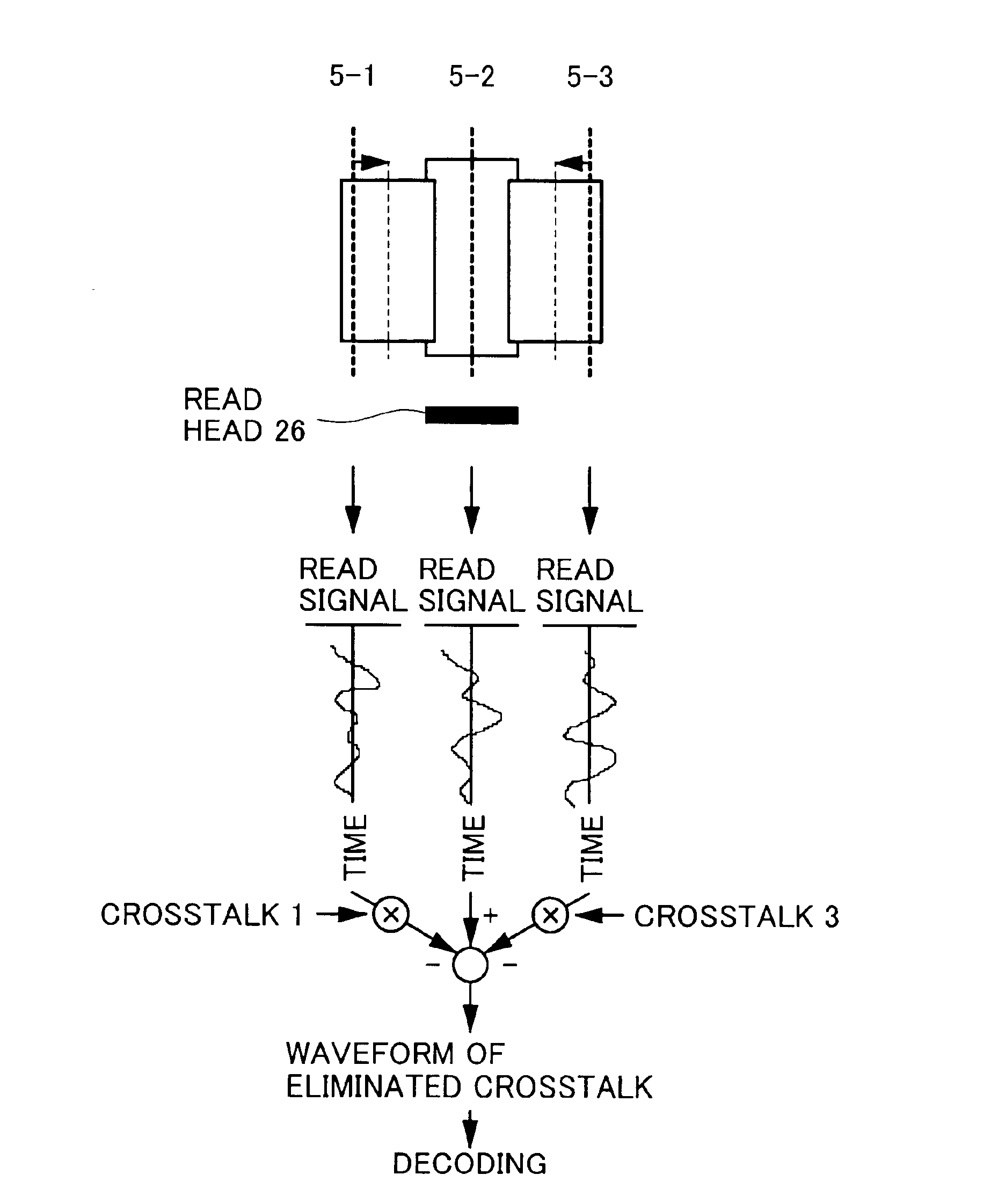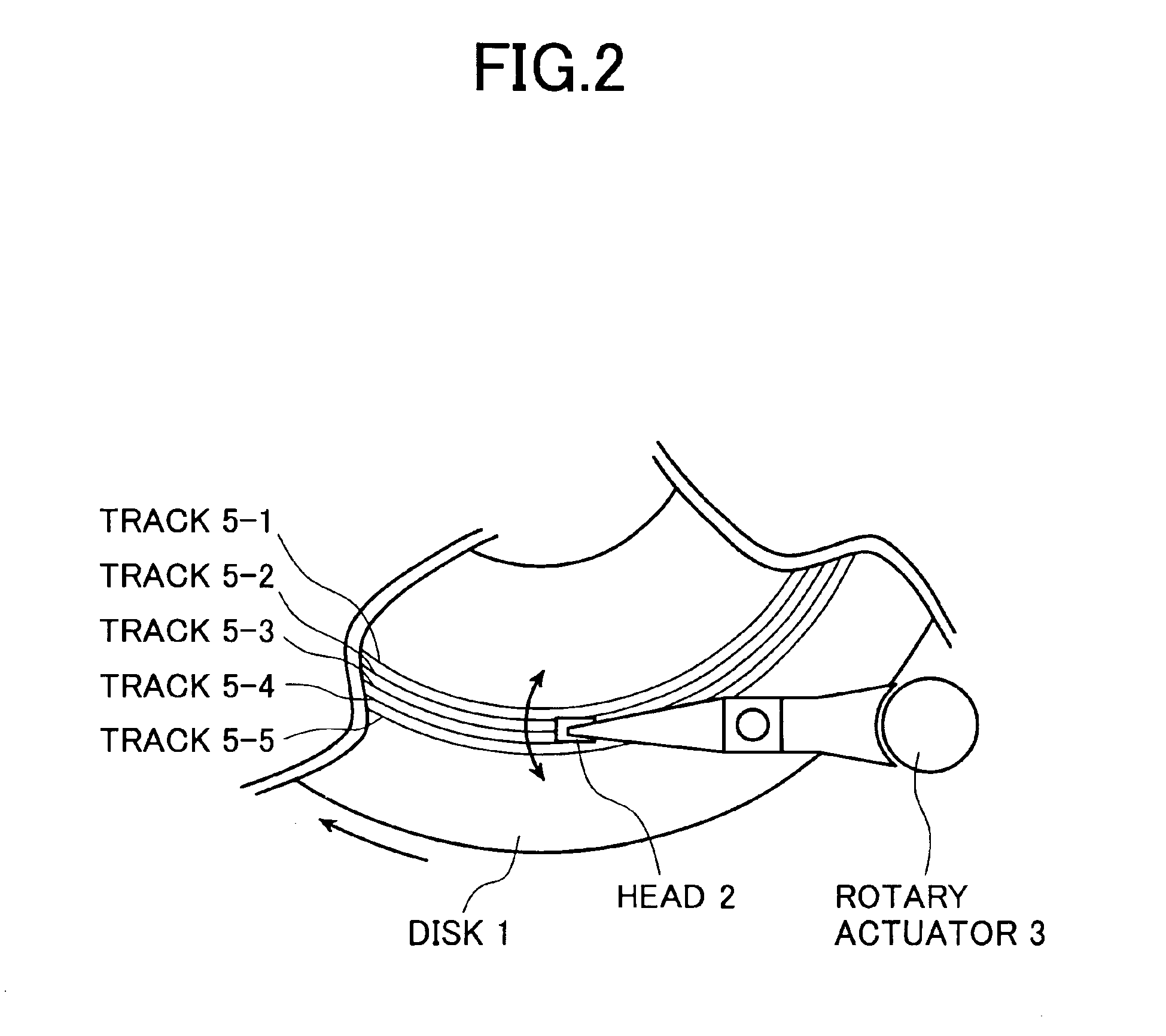Magnetic recording/reproducing device
- Summary
- Abstract
- Description
- Claims
- Application Information
AI Technical Summary
Benefits of technology
Problems solved by technology
Method used
Image
Examples
embodiment 1
(Embodiment 1)
[0025]The present invention will be described while taking the case of a magnetic disk device. A side view of the magnetic disk device is shown in FIG. 1. The magnetic disk device has disk (1-1 to 1-3, a head (2), a rotary actuator (3) and a spindle motor (4). The disk (1) is rotated by the spindle motor (4), and recording of data onto the disk (1) and reproducing of the data recorded are performed by the head (2). The head (2) is driven by the rotary actuator (3), and positioned at an optional position on the disk (1). For this reason, a plurality of tracks (5-1 to 5-5) exist on the disk as shown in FIG. 2, and the head (2) is moved onto any track by the rotary type actuator (3), thus performing the recording / reproducing operation. Servo sectors (6) in which recorded information for positioning the head exist discretely as shown in FIG. 3, and data sectors (7) for recording data exist plurality between the servo sectors (6). The disk is usually divided into several zo...
embodiment 2
(Embodiment 2)
[0028]The write frequency is changed for each one track as shown in FIG. 8. At this time, spectrum of a read back signal of the PLL pattern has frequency peaks (12, 13), respectively, at the positions corresponding to the PLL pattern frequency (F1 / 2) of the read-purposed track (5-3) and the PLL pattern frequency (F2 / 2) of the adjacent tracks (5-2, 5-4), as shown in FIG. 9. Herein, it is assumed that a position of the read head is x, an intensity of the read-purposed track signal at the position x is S1(x) and a crosstalk amount is S2(x). When a crosstalk value at this time is expressed by S2(x)S1(x), the relation between the position x of read head and the crosstalk value S2(x)S1(x) is illustrated so as to have a convex shape with a vertex directed downward as shown in FIG. 10. At the position of x1+Δx, the crosstalk value becomes S2(xl+Δx) / S1(x1+Δx). Assuming that S2(x1) / S1(x1)−S2(x1+Δx) / S1(x1+Δx) is equal to CT(x1, Δx), if CT(x1, Δx)>0 is satisfied when the read head...
embodiment 3
(Embodiment 3)
[0030]In the embodiments 1 and 2, when data straddling over the plurality of tracks is recorded, the head seeks tracks having the same write frequency, thus recording the data thereon. Specifically, in the case of the embodiment 1, when the first portion of the data Is recorded onto the track (5-1) recorded with the write frequency F1 and when all of a series of data cannot be recorded onto the track (5-1) as shown in FIG. 12, the head is allowed to seek the track (5-4) recorded with the same write frequency F1 as the track (5-1), and data which could not be recorded onto the track (5-1) is recorded onto the track (5-4).
[0031]Furthermore, in the case of the embodiment 2, as shown in FIG. 13, the first portion of the data is recorded onto the track (5-1) recorded with the write frequency F1, all of a series of data is not recorded onto the track (5-1), the head is allowed to seek the track (5-3) recording with the same write frequency F1 as the track (5-1), and data whi...
PUM
 Login to View More
Login to View More Abstract
Description
Claims
Application Information
 Login to View More
Login to View More - R&D
- Intellectual Property
- Life Sciences
- Materials
- Tech Scout
- Unparalleled Data Quality
- Higher Quality Content
- 60% Fewer Hallucinations
Browse by: Latest US Patents, China's latest patents, Technical Efficacy Thesaurus, Application Domain, Technology Topic, Popular Technical Reports.
© 2025 PatSnap. All rights reserved.Legal|Privacy policy|Modern Slavery Act Transparency Statement|Sitemap|About US| Contact US: help@patsnap.com



